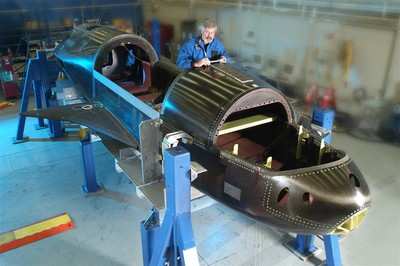Unmanned X-37B To Be Service's Space Test Vehicle
 The Air Force is
working on a space vehicle that will allow government scientists to
transport advanced technology into orbit, test its capability
there, then bring it home for further study.
The Air Force is
working on a space vehicle that will allow government scientists to
transport advanced technology into orbit, test its capability
there, then bring it home for further study.
The X-37B Orbital Test Vehicle is similar to the space shuttle,
except it's about a fourth the size and unmanned. The OTV can
return from space on its own, said Lieutenant Colonel Kevin Walker,
an Air Force Rapid Capabilities Office program manager.
"All you do from the ground is send up the command for it to
de-orbit, then stand back and it de-orbits itself," he said. "The
OTV gets itself ready for re-entry, descends through the
atmosphere, lines up on the runway, puts down its landing gear ...
and it does it all on its own."
The vehicle will land at either Vandenberg or Edwards Air Force
bases in California.
The OTV will serve as a test platform for satellites and other
space technologies. The vehicle allows satellite sensors,
subsystems, components and associated technology to be transported
into the environment where they will be used -- space.
OTV will catch a ride to orbit aboard an Atlas V launch vehicle.
Once in space, the OTV begins testing its payload. Colonel Walker
said the doors aboard the craft could simply open, exposing the
experiment bay, or mission scientists could design more elaborate
experiments.

"You could design something to extend itself out of the
experiment bay, or have it on a retractable arm, or it could just
stay inside the bay," Colonel Walker said. "The OTV is a very
flexible space test platform for any number of various
experiments."
Testing components in their actual operational environment will
allow scientists to better judge how those parts will perform when
deployed. That might allow designs with fewer redundant systems in
future satellites.
"Rather than build unproven components into a high-cost
satellite, with multiple layers of redundancy to make sure they
work -- you can use the OTV to get those components into space to
see how they respond to the environment, and make sure they work
the way they were designed," Colonel Walker said.
The Air Force's Rapid Capabilities Office has been tasked with
acquiring, testing and demonstrating the OTV. Colonel Walker said
much of the X-37B system vehicle is now being built and will soon
move into a testing phase.

Though the OTV is designed to provide a testing platform for new
space technologies, it is made up of several advanced, untested
technologies itself.
Randy Walden, RCO deputy and technical director, said there are
a number of cutting-edge technologies on the OTV besides the auto
de-orbit capability. It has new thermal protection tiles underneath
and high-temperature components and seals throughout that need to
be proven in orbit.
"There will be a great deal of extremely useful data coming from
the OTV on its first flights,' said Mr. Walden. "Our plan is to
share this data with other government agencies such as NASA."
The X-37 program, originally a NASA initiative, was transferred
to the Defense Advanced Research Projects Agency in 2004. The Air
Force's X-37B program builds upon the early development and testing
conducted by NASA, DARPA and the Air Force Research Laboratory.
ANN salutes SSgt C. Todd Lopez, Air Force Print
News
 ANN's Daily Aero-Term (04.25.24): Airport Rotating Beacon
ANN's Daily Aero-Term (04.25.24): Airport Rotating Beacon ANN's Daily Aero-Linx (04.25.24)
ANN's Daily Aero-Linx (04.25.24) Klyde Morris (04.22.24)
Klyde Morris (04.22.24) Airborne 04.24.24: INTEGRAL E, Elixir USA, M700 RVSM
Airborne 04.24.24: INTEGRAL E, Elixir USA, M700 RVSM Airborne 04.22.24: Rotor X Worsens, Airport Fees 4 FNB?, USMC Drone Pilot
Airborne 04.22.24: Rotor X Worsens, Airport Fees 4 FNB?, USMC Drone Pilot





